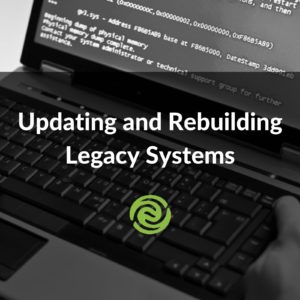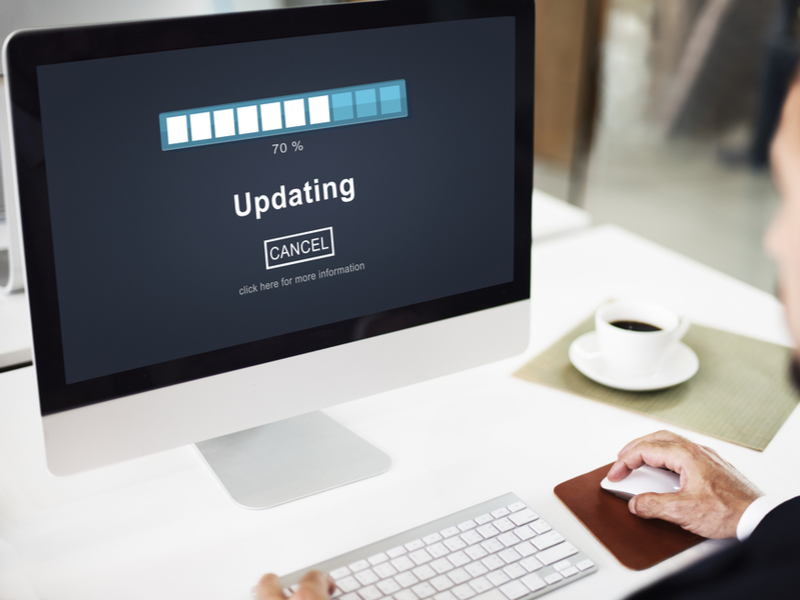You may have heard of Blockchain for cryptocurrency, but did you know this technology also…
Updating and Rebuilding Legacy Systems
 Many companies operate with legacy software systems that are still EXACTLY what the company needs, but they are written in older software platforms or languages. Sometimes, ownership cannot justify the investment needed in a complete system rewrite or the cost of a new system, because the legacy system still meets their needs.
Many companies operate with legacy software systems that are still EXACTLY what the company needs, but they are written in older software platforms or languages. Sometimes, ownership cannot justify the investment needed in a complete system rewrite or the cost of a new system, because the legacy system still meets their needs.
So, what can you do to improve your business’s legacy systems? This blog will help you answer that question. Before we get into updating and rebuilding, let’s quickly define “legacy software systems” and look at the challenges and inherent risks associated with older technologies.
What are Legacy Systems?
Legacy systems are typically on-premises core business software platforms and the underlying operating systems that you use to run your business or a portion of your business. Legacy systems usually work fine for what the business needs, they just use older software platforms written in older programming languages.
Getting rid of these systems altogether is usually not an option. However, introducing newer programming languages, swapping older components for newer ones, and at times, rebuilding portions of the application, with the ability to scale, are necessary to keep the application running and reduce risk to the business.
Thirty-one percent of an organization’s technology is made up of legacy systems. An average of 60–80% of IT budgets are allocated to keeping them running.” IT ProPortal
Inherent Risks with Legacy Systems
With any technology, there is the danger of accumulating technical debt… the debt you incur when you don’t take care of or maintain your technology. When the debt accumulates, it can become overwhelming and sometimes difficult to make any changes or upgrades at all. Continuing to limp along with outdated software becomes an “if it ain’t broken, don’t fix it” way of thinking. Running a company with older software applications can create unnecessary challenges and could jeopardize efficiency.
Sometimes, these older languages present issues or other risks to an organization. Risks may include poor security, loss of productivity, inability to update systems, data loss, limited usability, and inferior company culture.
Inherent legacy system risks:
- Modifying the software application or adding functionality can be a challenge
- Your developer may no longer be available or you have may difficulty finding a developer that knows the older technology
- The outdated language is no longer being supported by the company that created the language
- Legacy systems can provide security risks
- Large amounts of data are sometimes siloed and may need to be connected to
- Old technology may create compliance issues
- There are hidden costs associated with inefficiency, downtime, frustrated staff, and reduced customer satisfaction
The importance of positive company culture is largely underestimated, and technology has a lot to do with it. From the G2.com State of Software report, “Roughly 52% of employees are unhappy at work due to the software tools they’re using; 24% have considered leaving because they don’t have the right software. Ninety-five percent said they would be ‘very satisfied’ or ‘satisfied’ if they had better software tools at work.” Keep in mind that when employees are happy, customers are happy.
By taking your legacy systems off-premises to a cloud environment using a VPN or other secure connection, and updating or rebuilding your systems, your company can embark on a digital transformation and achieve long-term business success.
Updating and/or rebuilding legacy systems quickly boosts productivity, which boosts employee morale.
Updates to Legacy Systems
To determine if a software system or application update is the best option, examine your current systems and their ability to be updated. If they’re not too old, an update may be possible.
For off-the-shelf software, you can check with your vendor to see if there is an upgrade path that they have already mapped out. Software companies will typically do this so they don’t lose legacy customers over time.
For custom software solutions, you can check with your software development company to see if there is a way to upgrade older technologies. Some examples of updatable software languages may include, but are in no way limited to…
- Visual Basic 6 (VB6)
- PHP
- Java
- FoxPro
- Access
- Delphi
- SQL Server
- MySQL
- Various Content Management Systems (CMS)
Once it’s determined that your software can be updated to a newer version of the same programming language, your software developer can help you design an upgrade path. In some cases, this is as simple as running an upgrade wizard and managing the upgrade process.
It’s estimated 90% of businesses are held back in terms of growth and enhanced efficiency due to old technology.”– ComputerWeekly.com
It is also possible that your legacy systems have older components that can be swapped out with newer technology. For instance, you could upgrade an Access application to use a SQL Server database backend but still use the Access user interface.
Benefits of Updating Your Legacy Systems
- Save the investment you have in the legacy system
- Breathe new life into an older system that still works well
- Give a legacy system another 5–10 year lifespan
- Use the upgrade as an interim step before replacing the system
- Use the upgrade as an interim step while the system is being rewritten
- Enhance efficiencies in your operations
- Do more work with less effort
- Reduce business risk
- Eliminate security risks
- Improve company culture
- Enrich user experience
- Increase profitability
Updating may be something your IT department can do, or you can work with an external software development company, such as Swip Systems, to assist with updates and upgrades.
By innovating and providing an easy customer experience via technology, customers will be drawn to your brand, which helps to increase profits.
Rebuilding Legacy Systems
If the main component of your legacy system needs some maintenance along with updates, it may make sense to move functioning portions of the system into a new application where core logic can be reused. For instance, you may no longer use given areas of an application but still rely heavily on some of the core functionality.
The unused functionality can be removed and the core functionality that is still in use can be moved into a newer software development platform. For instance, a library can be made into an API and ported over to a newer software development platform for another life within the overall system.
Another scenario is that it might be time to write a new version of portions of the system using the old system as a template. It’s much easier to build a pizza when you have a finished pizza as a template, as opposed to not having anything to start with.
Maybe you have an older software system that is still working well, but customers need to access it via a web interface. In this case, you can put a web or mobile user interface in front of it through an API connection.
Benefits of Rebuilding Your Legacy System
- Save the initial investment
- Reduce business risk
- Breathe new life into an older system that still works well
- Gain a competitive advantage
- Advance scalability
- Maintain compliance
- Eliminate security risks
- Utilize business process automation
- Do more work with less effort
- Enrich company culture
- Enrich user experience with a better user interface (UI/UX)
- Save money in the long run
- Increase profitability
The Bottom Line … Transform Your Business with Newer Technology
Investing in newer technology is ultimately more cost-effective than continuing to fund and work with patched-up legacy systems. All in all, updating, upgrading, or rebuilding older technology will help your business be the best that it can be.
If you have been struggling with a legacy system and just haven’t had the time or skillset to decide how to address it, Swip Systems is here to help. We can take the burden of the initial analysis, cost estimations, timeline, and updating and/or rebuilding off your shoulders. We can work with your IT team or become your external software development partner to move your company into the realm of digital transformation.
Contact us today for a free conversation about your legacy systems. 877.377.SWIP










